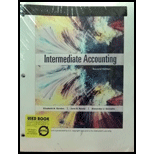
Intermediate Accounting, Student Value Edition (2nd Edition)
2nd Edition
ISBN: 9780134732145
Author: Elizabeth A. Gordon, Jana S. Raedy, Alexander J. Sannella
Publisher: PEARSON
expand_more
expand_more
format_list_bulleted
Question
Chapter 21, Problem 21.3P
a.
To determine
To prepare: Comparative income statement for WI after the change to FIFO.
b.
To determine
After tax cumulative effect in retained earnings balance for the first balance sheet presented.
Expert Solution & Answer
Want to see the full answer?
Check out a sample textbook solution
Students have asked these similar questions
Goodwill is an example of an indefinite-life intangible asset, meaning that public companies must test it for impairment rather than regularly amortizing to systematically reduce its value on the balance sheet of the public company.
Can anyone recap the difference between limited-life versus indefinite-life intangible assets? Any specific examples of either category?
Why are adjusting journal entries necessary at the end of an accounting period? Need he
Why are adjusting journal entries necessary at the end of an accounting period?i need help
Chapter 21 Solutions
Intermediate Accounting, Student Value Edition (2nd Edition)
Ch. 21 - Are accounting changes permitted in financial...Ch. 21 - How do firms report accounting changes under the...Ch. 21 - Prob. 21.3QCh. 21 - How do firms account for changes in accounting...Ch. 21 - Prob. 21.5QCh. 21 - Prob. 21.6QCh. 21 - Prob. 21.7QCh. 21 - Prob. 21.8QCh. 21 - Do accounting errors that self-correct within two...Ch. 21 - Does a firm need to correct an error that...
Ch. 21 - Prob. 21.1MCCh. 21 - Prob. 21.2MCCh. 21 - Prob. 21.3MCCh. 21 - Prob. 21.4MCCh. 21 - Prob. 21.5MCCh. 21 - Prob. 21.1BECh. 21 - Prob. 21.2BECh. 21 - Prob. 21.3BECh. 21 - Prob. 21.4BECh. 21 - Change in Accounting Principle, Long-Term...Ch. 21 - Prob. 21.6BECh. 21 - Prob. 21.7BECh. 21 - Prob. 21.8BECh. 21 - Prob. 21.9BECh. 21 - Prob. 21.10BECh. 21 - Prob. 21.11BECh. 21 - Prob. 21.12BECh. 21 - Prob. 21.13BECh. 21 - Prob. 21.14BECh. 21 - Change in Accounting Principle, Inventory. Massi...Ch. 21 - Change in Accounting Principle, Long-Term...Ch. 21 - Prob. 21.3ECh. 21 - Change in Accounting Principle, Inventory. Winthur...Ch. 21 - Prob. 21.5ECh. 21 - Prob. 21.6ECh. 21 - Error Analysis and Correction. Feinstein and...Ch. 21 - Prob. 21.8ECh. 21 - Prob. 21.9ECh. 21 - Prob. 21.10ECh. 21 - Change in Accounting Principle, Inventory. Second...Ch. 21 - Prob. 21.2PCh. 21 - Prob. 21.3PCh. 21 - Prob. 21.4PCh. 21 - Prob. 21.5PCh. 21 - Change in Estimate, Inventory, Bad Debt Expense....Ch. 21 - Prob. 21.7PCh. 21 - Cases Judgment Case Judgment Case: Materiality and...Ch. 21 - Prob. 1FSCCh. 21 - Surfing the Standards: Change in Accounting...Ch. 21 - Prob. 1BCC
Knowledge Booster
Learn more about
Need a deep-dive on the concept behind this application? Look no further. Learn more about this topic, accounting and related others by exploring similar questions and additional content below.Similar questions
arrow_back_ios
SEE MORE QUESTIONS
arrow_forward_ios
Recommended textbooks for you
 Cornerstones of Financial AccountingAccountingISBN:9781337690881Author:Jay Rich, Jeff JonesPublisher:Cengage LearningPrinciples of Accounting Volume 1AccountingISBN:9781947172685Author:OpenStaxPublisher:OpenStax College
Cornerstones of Financial AccountingAccountingISBN:9781337690881Author:Jay Rich, Jeff JonesPublisher:Cengage LearningPrinciples of Accounting Volume 1AccountingISBN:9781947172685Author:OpenStaxPublisher:OpenStax College Intermediate Accounting: Reporting And AnalysisAccountingISBN:9781337788281Author:James M. Wahlen, Jefferson P. Jones, Donald PagachPublisher:Cengage Learning
Intermediate Accounting: Reporting And AnalysisAccountingISBN:9781337788281Author:James M. Wahlen, Jefferson P. Jones, Donald PagachPublisher:Cengage Learning Financial AccountingAccountingISBN:9781337272124Author:Carl Warren, James M. Reeve, Jonathan DuchacPublisher:Cengage Learning
Financial AccountingAccountingISBN:9781337272124Author:Carl Warren, James M. Reeve, Jonathan DuchacPublisher:Cengage Learning Financial Accounting: The Impact on Decision Make...AccountingISBN:9781305654174Author:Gary A. Porter, Curtis L. NortonPublisher:Cengage Learning
Financial Accounting: The Impact on Decision Make...AccountingISBN:9781305654174Author:Gary A. Porter, Curtis L. NortonPublisher:Cengage Learning

Cornerstones of Financial Accounting
Accounting
ISBN:9781337690881
Author:Jay Rich, Jeff Jones
Publisher:Cengage Learning

Principles of Accounting Volume 1
Accounting
ISBN:9781947172685
Author:OpenStax
Publisher:OpenStax College

Intermediate Accounting: Reporting And Analysis
Accounting
ISBN:9781337788281
Author:James M. Wahlen, Jefferson P. Jones, Donald Pagach
Publisher:Cengage Learning

Financial Accounting
Accounting
ISBN:9781337272124
Author:Carl Warren, James M. Reeve, Jonathan Duchac
Publisher:Cengage Learning


Financial Accounting: The Impact on Decision Make...
Accounting
ISBN:9781305654174
Author:Gary A. Porter, Curtis L. Norton
Publisher:Cengage Learning
Accounting Changes and Error Analysis: Intermediate Accounting Chapter 22; Author: Finally Learn;https://www.youtube.com/watch?v=c2uQdN53MV4;License: Standard Youtube License